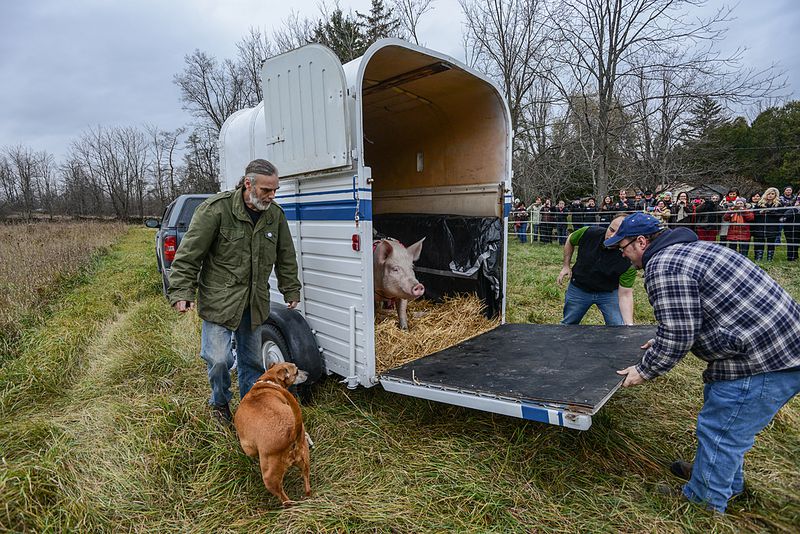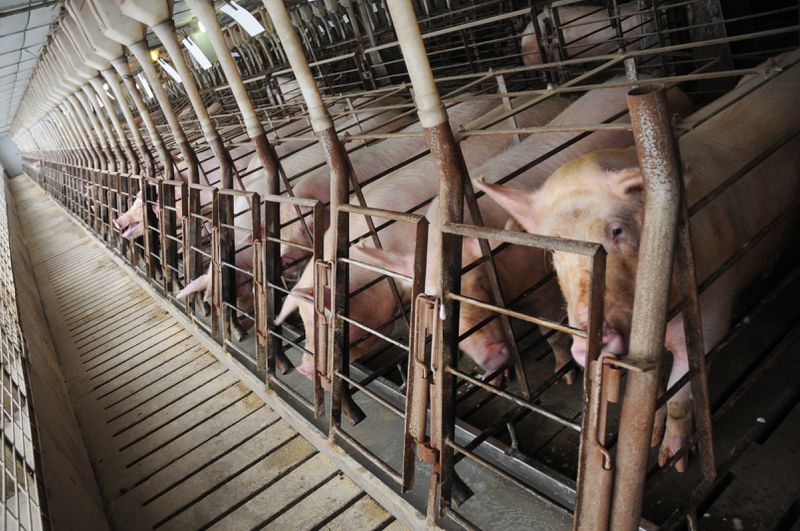
How Esther the Wonder Pig put a face to factory farming.
Esther the Wonder Pig — a world-famous pig who was one of the few of her kind to escape the fate of the factory farm and slaughterhouse to live life on her own terms — died peacefully last month, at 11 years old. Her life as a pet pig, extensively documented on social media, helped show millions the individuality of the animals we typically call food, and challenged people to see them in a new light.
Esther’s story began in 2012, when Steve Jenkins, a real estate agent in the Toronto suburbs, adopted her when she weighed just 5 pounds — a decision that changed the course of his life.
By then, animal videos had come to rule the internet, and Jenkins was not immune to the cuteness of pigs’ big eyes, round snouts, and light pink skin. So when an old friend asked him if he’d take a piglet off her hands, Jenkins said yes — without consulting his then-partner, Derek Walter, he told me with a laugh — and picked up the unusual pet the next day.
Esther quickly won over Derek, and she soon became another member of the family, taking up space on the couch alongside their cat and dogs. And just like a puppy, young Esther was full of energy. She was also exceptionally smart, Jenkins said. It was a cinch to potty train her and teach her to “sit,” and she even figured out that she could use her snout to open up the cupboard where the dog treats were stored. She was incredibly affectionate, too, curling into their laps while they watched TV at night.
“Everything about her blew my mind,” Jenkins said. His mind was also blown when he learned how big she’d grow.
“This is not a potbelly or mini pig; I think you have a commercial pig on your hands,” a veterinarian told them during Esther’s first appointment, about a month and a half after they’d taken her in. Jenkins’s friend had told him Esther might grow to 70 pounds, about the size of a golden retriever. Commercial pigs, however — bred to grow big and fast — can reach 600 pounds within a few years.
The duo never got the full story about where Esther came from, but they learned she was a Yorkshire, the most common commercial pig breed in North America. Pigs just like her are kept as breeding sows by the pork industry, spending their lives on concrete floors in tiny cages unable to turn around.
Worried about the challenges of keeping an enormous pig in their suburban home, Jenkins and Walter called a number of animal sanctuaries to see if any could take her in, but they were all full. There was no chance they were going to send her to a farm only to eventually be slaughtered. So they kept her, and to share the adventure with friends and family, they set up a Facebook page. In six weeks, to their surprise, Esther’s fanbase shot from zero to 50,000.
“All of a sudden, news channels were calling, and [there were] newspaper articles and blog posts and all kinds of stuff about this big pig who lived in a house with these two guys in Canada, and it went nuts,” Jenkins said. They got a book deal. “It all happened so, so fast.”
Their neighborhood didn’t allow hooved animals as pets, so they started a fundraising campaign to purchase land in rural Ontario so they could open up an animal sanctuary for Esther, and future rescued animals, to have more space.
Less than a year after they had started the Facebook page, they opened Happily Ever Esther Farm Sanctuary 40 miles southwest of Toronto, which is now home to a menagerie of rescued animals: 28 pigs, 19 chickens, five goats, three ducks, three sheep, two cows, two cats, one rabbit, one donkey, one horse, and a peacock named Jerry. (Esther never took to the barn they built for her, choosing to stay indoors with her dads.)

Jo-Anne McArthur/We Animals Media
Esther eventually attracted over 1.5 million fans on Facebook alone, including Paris Hilton, Ellen DeGeneres, Greta Thunberg, Jim Parsons, and Ricky Gervais. In 2016, Jenkins and Walter published their book; a children’s book and another nonfiction book followed. In 2017, Esther was diagnosed with breast cancer and beat it.
Last month, however, her dads had to make the gut-wrenching decision to euthanize Esther after a year of watching her health decline due to arthritis complications that had begun to affect her spine. She died on the evening of October 18, surrounded by loved ones in the sunroom where she spent many of her days.
What Esther taught the world
One of the difficulties in persuading people to care about farmed animals is that people rarely come into contact with them, unlike pets and wild animals. In the case of pigs, only a few have ever inspired sympathy on a large scale, and they’re largely fictional — like the pigs in the films Babe, Charlotte’s Web, and Okja.
Activists often talk about factory farming in terms of its massive scale, as there are 92.2 billion animals raised annually on land around the globe, most of them confined in windowless sheds in remote areas. They’re never given names, and we don’t know their stories. As a result, animals are the “absent referent” in our relationship to food, according to author and activist Carol J. Adams:
Behind every meal of meat is an absence: the death of the animal whose place the meat takes. The absent referent is that which separates the meat eater from the animal and the animal from the end product. The function of the absent referent is to keep our “meat” separated from any idea that she or he was once an animal, to keep the “moo”; or “cluck” or “baa” away from the meat, to keep something from being seen as having been someone.
For many, Esther filled that absence, and it began with her dads: Just a few months after Jenkins and Walter brought her home, they could no longer look at bacon the same way.

Harold Hoch/MediaNews Group via Getty Images
“I was always an animal lover, but I would go out of my way to avoid asking myself or having to answer those hard questions” about the suffering of animals raised for food, Jenkins said. After adopting Esther, they decided to stop eating pork, and the more they looked into meat and dairy production, the more they felt they had to cut out other animal products too. Eventually, they became vegan.
Esther had the same effect on a lot of her followers, even though Jenkins and Walter rarely used the term “vegan,” instead calling their recipes “Esther-approved.”
Jenkins said that many would follow the page for the same reason that he first decided to take her home — simply because she was cute. But they’d stay engaged because the posts were humorous and uplifting and entertaining: Esther in a wig, Esther devouring cupcakes, Esther napping with a dog. And then, at the grocery store, followers might put bacon in their cart, think of her, and put it back, or feel discomfort after ordering their favorite pulled pork sandwich.
“That was a recurring theme,” Jenkins said, noting that he constantly received messages in which people shared such experiences. “They knew what she was, they knew where she came from. It was no longer just pork — it was somebody, it was Esther. It gave food a face in a way they could relate to. That face meant something to them.”
Research has shown that people are a lot more likely to care about a problem if they get to know an individual affected by it as opposed to learning about a large group of faceless individuals. And seeing Esther in a home as a pet, instead of in a factory farm as a future piece of meat, enabled people to see other animals raised for food differently, too.
According to Garrett Broad, a Vox contributor and communications professor at Rowan University, people generally sort animals into four categories: food, companions, wildlife, and pests. It’s the job of animal rights activists, essentially, to shake up these categories and move animals from “food” or “pest” to “companion” or “wildlife.” Esther and her dads did that for a lot of people, even if they fell into it by accident.
It’s an observation that more activists could learn from. Much of the movement against factory farming seeks to shock people’s conscience by exposing the meat industry’s depravity and immense scale. That approach certainly works on some (it’s what inspired me to care), but it neglects two simple but obvious truths of social change: Most people are moved by stories, not statistics, and sometimes a lighter touch is more effective than a heavy hand.
While many people cite factory farm exposés and conversations with friends as the primary motivators to become vegetarian or vegan, many also say a positive interaction with an animal or posts on social media inspired the change. Few of Esther’s followers ever met her in real life, but they developed a parasocial relationship that clearly had an effect.
There are limitations to the approach. For one, animal sanctuaries that care for rescued farm animals are costly to operate and only help a tiny number of animals, relative to the massive factory farming industry. Plus, Jenkins told me, he worried Esther’s social media accounts increased the demand for pet pigs. He often had to dissuade people from buying them, explaining the significant space and time they require to be properly cared for. Even the smallest breeds can grow to 100 pounds. (Plus, buying pigs only helps support the pig breeding industry.)
But if done thoughtfully, as Jenkins and Walter have, animal rescue can be a powerful force for painting a utopian vision for change. As Vox’s Marina Bolotnikova has written, rescue “enacts the ultimate outcome that activists want to achieve for farmed animals, which is freedom from exploitation and commodification.”
Of course, Esther’s life was much more than a case study in effective activism. She was also an individual who had her own quirks and preferences, and just by being herself (and with help from her loving dads), she inspired people around the world to believe every animal should get to be themselves, too.
A version of this newsletter originally appeared in the Future Perfect newsletter. Sign up here!
----------------------------------------
By: Kenny Torrella
Title: Can a social media “pigfluencer” turn people off bacon?
Sourced From: www.vox.com/future-perfect/23940933/esther-the-wonder-pig-meat-factory-farming-rescue
Published Date: Fri, 03 Nov 2023 13:00:00 +0000
Did you miss our previous article...
https://consumernewsnetwork.com/politics-us/ftx-founder-sam-bankmanfried-guilty-on-all-counts-of-fraud-after-historic-cryptocurrency-collapse






